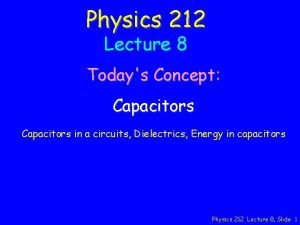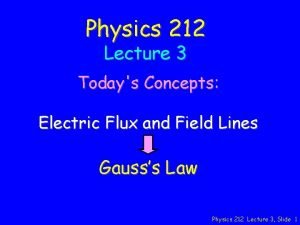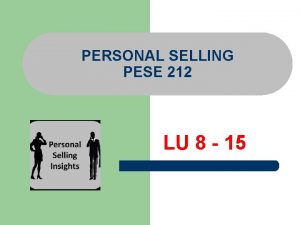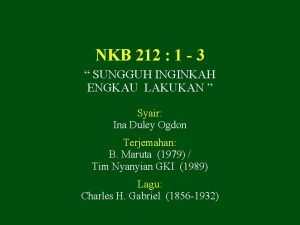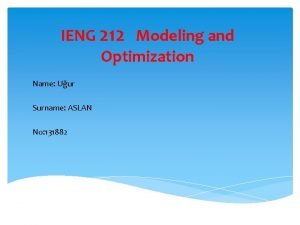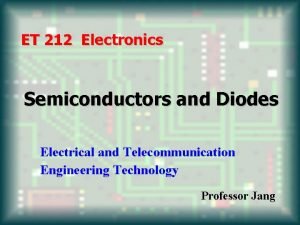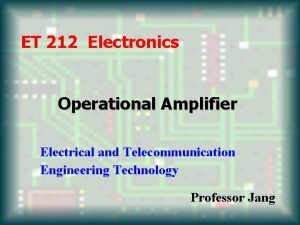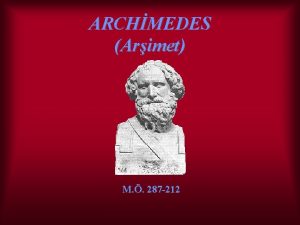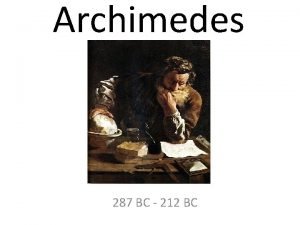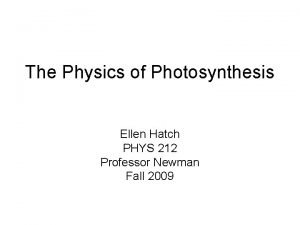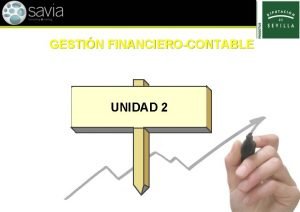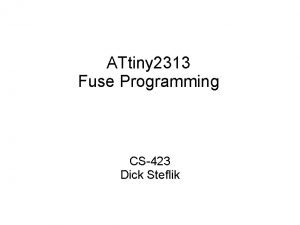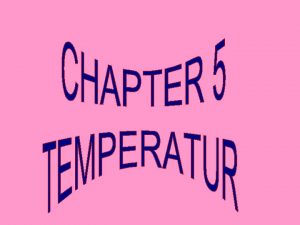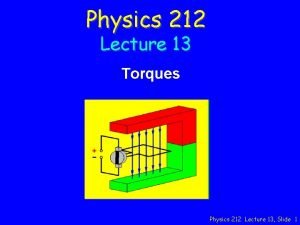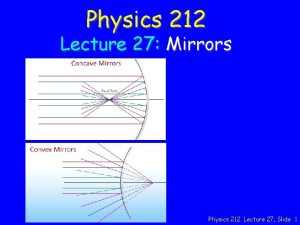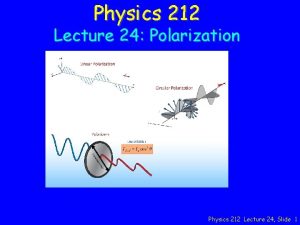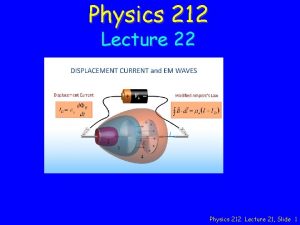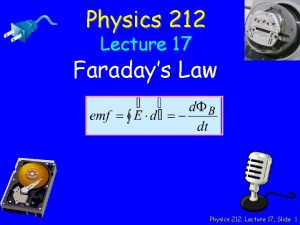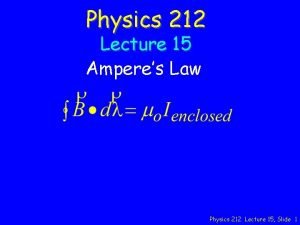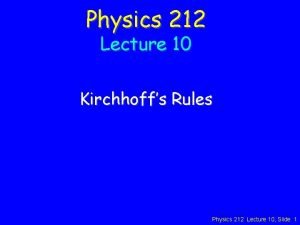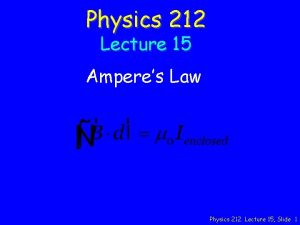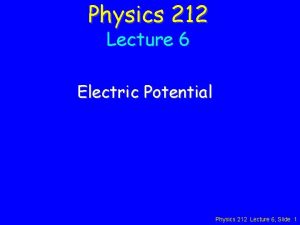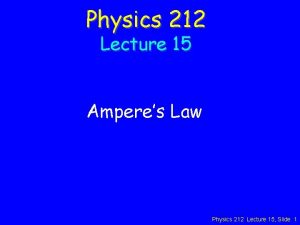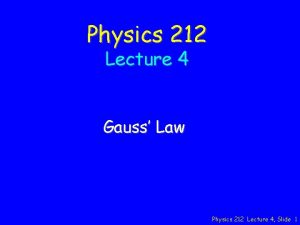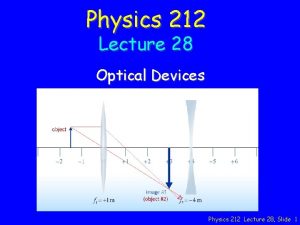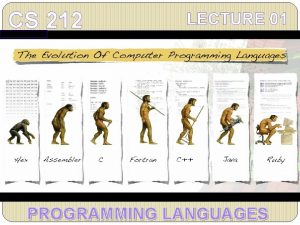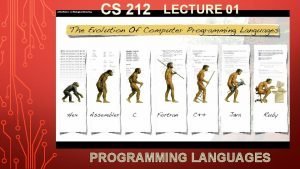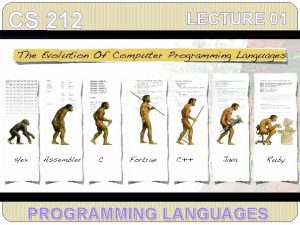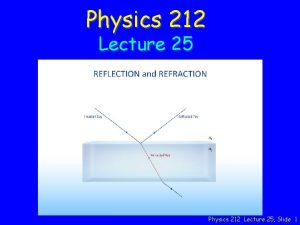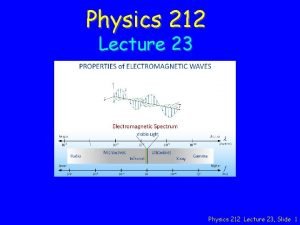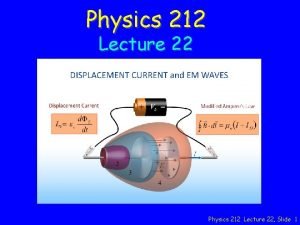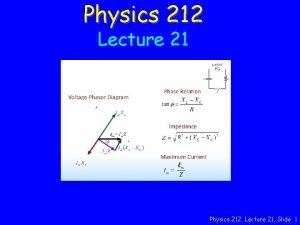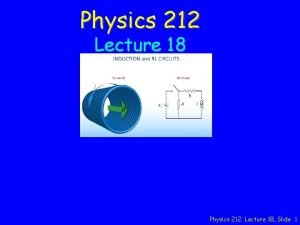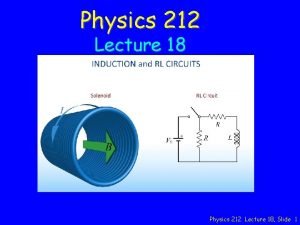Physics 212 Lecture 18 Slide 1 From the






















- Slides: 22

Physics 212 Lecture 18, Slide 1

From the prelecture: Self Inductance Wrap a wire into a coil to make an “inductor”… e = -L d. I dt Physics 212 Lecture 18, Slide 2

What this really means: emf induced across L tries to keep I constant e. L = -L d. I dt L current I Inductors prevent discontinuous current changes ! It’s like inertia! Physics 212 Lecture 18, Slide 3

I(t) e = -L d. I dt Suppose d. I/dt > 0. Induced EMF tries to counteract this change (Lenz’s Law). e + I(t) - V 1 V 2 + - Voltage across inductor V 1 – V 2 = VL = + L d. I/dt > 0

Checkpoint 1 Two solenoids are made with the same cross sectional area and total number of turns. Inductor B is twice as long as inductor A (1/2)2 2 Compare the inductance of the two solenoids A) LA = 4 LB B) LA = 2 LB C) LA = LB D) LA = (1/2) LB E) LA = (1/4) LB Physics 212 Lecture 18, Slide 5

WHAT ARE INDUCTORS AND CAPACITORS GOOD FOR? Inside your i-clicker Physics 212 Lecture 18, Slide 6

How to think about RL circuits Episode 1: When no current is flowing initially: VL I=0 L I=V/R R L t = L/R R I VBATT At t = 0: I=0 VL = VBATT VR = 0 (L is like a giant resistor) VBATT t = L/R At t >> L/R: VL = 0 VR = VBATT I = VBATT/R (L is like a short circuit) Physics 212 Lecture 18, Slide 7

Checkpoint 2 a In the circuit, the switch has been open for a long time, and the current is zero everywhere. I At time t=0 the switch is closed. What is the current I through the vertical resistor immediately after the switch is closed? I IL=0 (+ is in the direction of the arrow) A) I = V/R B) I = V/2 R C) I = 0 D) I = -V/2 R E) I = -V/R Before: IL = 0 After: IL = 0 I = + V/2 R Physics 212 Lecture 18, Slide 8

RL Circuit (Long Time) What is the current I through the vertical resistor after the switch has been closed for a long time? (+ is in the direction of the arrow) A) I = V/R B) I = V/2 R C) I = 0 D) I = -V/2 R E) I = -V/R After a long time in any static circuit: VL = 0 - + + - KVR: VL + IR = 0 Physics 212 Lecture 18, Slide 9

Checkpoint 2 b After a long time, the switch is opened, abruptly disconnecting the battery from the circuit. What is the current I through the vertical resistor immediately after the switch is opened? (+ is in the direction of the arrow) A) I = V/R B) I = V/2 R C) I = 0 D) I = -V/2 R E) I = -V/R Current through inductor cannot change DISCONTINUOUSLY circuit when switch opened L IL=V/R R Physics 212 Lecture 18, Slide 10

Why is there exponential behavior ? I 2 V 1 – V 2 = L d. I dt L 1 VL 3 R t = L/R V 3 -V 4 = IR 4 t = L/R where Physics 212 Lecture 18, Slide 11

I L VL R VBATT t = L/R Lecture: Prelecture: Did we mess up? ? No: The resistance is simply twice as big in one case. Physics 212 Lecture 18, Slide 12

Checkpoint 3 a After long time at 0, moved to 1 After long time at 0, moved to 2 After switch moved, which case has larger time constant? A) Case 1 B) Case 2 C) The same Physics 212 Lecture 18, Slide 13

Checkpoint 3 b After long time at 0, moved to 1 After long time at 0, moved to 2 Immediately after switch moved, in which case is the voltage across the inductor larger? A) Case 1 After switch moved: B) Case 2 C) The same Before switch moved: Physics 212 Lecture 18, Slide 14

Checkpoint 3 c After long time at 0, moved to 1 After long time at 0, moved to 2 After switch moved for finite time, in which case is the current through the inductor larger? A) Case 1 After awhile B) Case 2 C) The same Immediately after: Physics 212 Lecture 18, Slide 15

Calculation The switch in the circuit shown has been open for a long time. At t = 0, the switch is closed. What is d. IL/dt, the time rate of change of the current through the inductor immediately after switch is closed R 1 V R 2 L R 3 • Conceptual Analysis – – Once switch is closed, currents will flow through this 2 -loop circuit. KVR and KCR can be used to determine currents as a function of time. • Strategic Analysis – – – Determine currents immediately after switch is closed. Determine voltage across inductor immediately after switch is closed. Determine d. IL/dt immediately after switch is closed. Physics 212 Lecture 18, Slide 16

Calculation The switch in the circuit shown has been open for a long time. At t = 0, the switch is closed. R 1 V R 2 L IL = 0 R 3 What is IL, the current in the inductor, immediately after the switch is closed? (A) IL =V/R 1 up (B) IL =V/R 1 down (C) IL = 0 INDUCTORS: Current cannot change discontinuously ! Current through inductor immediately AFTER switch is closed IS THE SAME AS the current through inductor immediately BEFORE switch is closed Immediately before switch is closed: IL = 0 since no battery in loop Physics 212 Lecture 18, Slide 17

Calculation The switch in the circuit shown has been open for a long time. At t = 0, the switch is closed. R 1 V R 2 L R 3 IL(t=0+) = 0 What is the magnitude of I 2, the current in R 2, immediately after the switch is closed? (A) (B) (C) (D) We know IL = 0 immediately after switch is closed R 1 Immediately after switch is closed, V circuit looks like: I R 2 R 3 Physics 212 Lecture 18, Slide 18

Calculation The switch in the circuit shown has been open for a long time. At t = 0, the switch is closed. R 1 V IL(t=0+) = 0 R 2 L I 2 R 3 I 2(t=0+) = V/(R 1+R 2+R 3) What is the magnitude of VL, the voltage across the inductor, immediately after the switch is closed? (A) (B) (C) (D) (E) Kirchhoff’s Voltage Law, VL-I 2 R 2 -I 2 R 3 =0 VL = I 2 (R 2+R 3) Physics 212 Lecture 18, Slide 19

Calculation The switch in the circuit shown has been open for a long time. At t = 0, the switch is closed. What is d. IL/dt, the time rate of change of the current through the inductor immediately after switch is closed (A) (B) (C) R 1 V R 2 L R 3 VL(t=0+) = V(R 2+R 3)/(R 1+R 2+R 3) (D) The time rate of change of current through the inductor (d. I L /dt) = VL /L Physics 212 Lecture 18, Slide 20

Follow Up The switch in the circuit shown has been closed for a long time. What is I 2, the current through R 2 ? (Positive values indicate current flows to the right) (A) (B) R 1 V R 2 L (C) R 3 (D) After a long time, d. I/dt = 0 Therefore, the voltage across L = 0 Therefore the voltage across R 2 + R 3 = 0 Therefore the current through R 2 + R 3 must be zero !! Physics 212 Lecture 18, Slide 21

Follow Up 2 The switch in the circuit shown has been closed for a long time at which point, the switch is opened. R 1 (A) (B) (C) I 2 IL V What is I 2, the current through R 2 immediately after switch is opened ? (Positive values indicate current flows to the right) R 2 L (D) R 3 (E) Current through inductor immediately AFTER switch is opened IS THE SAME AS the current through inductor immediately BEFORE switch is opened Immediately BEFORE switch is opened: IL = V/R 1 Immediately AFTER switch is opened: IL flows in right loop Therefore, IL = -V/R 1 Physics 212 Lecture 18, Slide 22
 Q=vc physics
Q=vc physics Physics 212 gradebook
Physics 212 gradebook Heel toe polka dance steps
Heel toe polka dance steps 01:640:244 lecture notes - lecture 15: plat, idah, farad
01:640:244 lecture notes - lecture 15: plat, idah, farad Physics 111 lecture notes
Physics 111 lecture notes Physics 101 lecture notes pdf
Physics 101 lecture notes pdf Physics 101 lecture 1
Physics 101 lecture 1 Physics 101 lecture notes pdf
Physics 101 lecture notes pdf Waves pdf download
Waves pdf download Atmospheric physics lecture notes
Atmospheric physics lecture notes Pese 212
Pese 212 Sungguh inginkah engkau lakukan
Sungguh inginkah engkau lakukan Ienf-212
Ienf-212 Et 212
Et 212 Et 212
Et 212 Arm reach 212 cm on tiptoes
Arm reach 212 cm on tiptoes Archimedes ( arşimet) (mö 287–212 )
Archimedes ( arşimet) (mö 287–212 ) 287-212
287-212 Phys 212 equation sheet
Phys 212 equation sheet 212 instalaciones tecnicas ejemplos
212 instalaciones tecnicas ejemplos Ckdiv
Ckdiv X:3=212
X:3=212 Sebatang baja (angka muai linear 10
Sebatang baja (angka muai linear 10
